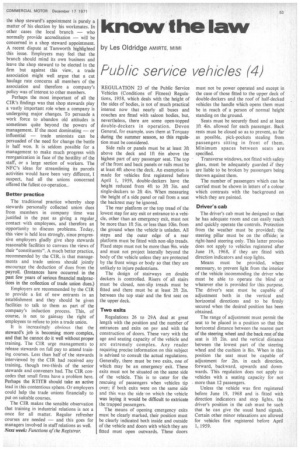know the law
Page 55

If you've noticed an error in this article please click here to report it so we can fix it.
by Les Oldridge AMIRTE MIMI
Public service vehicles (4)
REGULATION 23 of the Public Service Vehicles (Conditions of Fitness) Regulations, 1958, which deals with the height of the sides of bodies, is not of much practical interest now that nearly all buses and coaches are fitted with saloon bodies, but, nevertheless, there are some open-topped double-deckers in operation. Devon General, for example. uses them at Torquay during the summer season, so this regulation must be considered.
Side rails or panels must be at least 3ft above the deck and 1ft 6in above the highest part of any passenger seat. The top of the front and back panels or rails must be at least 4ft above the deck. An exemption is made for vehicles first registered before April 1, 1959, double-deckers have the height reduced from 4ft to 3ft 3in. and single-deckers to 2f1 4in. When measuring the height of a side panel or rail from a seat the backrest may be ignored.
The rear platform or the top tread of the lowest step for any exit or entrance to a vehicle, other than an emergency exit, must not be more than lit 5in, or less than 10in, from the ground when the vehicle is unladen. All steps and the outer edge of a rear platform must be fitted with non-slip treads. Fixed steps must not be more than 9in. wide and must not project laterally beyond the body of the vehicle unless they are protected by the front wings or body so that they are unlikely to injure pedestrians.
The design of stairways on double deckers is controlled. Risers of all stairs must be closed, non-slip treads must be fitted and there must be at least 2ft 2in. between the top stair and the first seat on the upper deck.
Two exits
Regulations 26 to 29A deal at great length with the position and the number of entrances and exits on psv and with the construction of doors. These vary with the age and seating capacity of the vehicle and are extremely complex. Any reader requiring precise information on this subject is advised to consult the actual regulations. Generally, there must be two exits, one of which may be an emergency exit. These exits must not be situated on the same side of the vehicle. This is to cater for the rescuing of passengers when vehicles tip over; if both exits were on the same side and this was the side-on which the vehicle was laying it would be difficult to extricate the trapped passengers.
The means of opening emergency exits must be clearly marked, their position must be clearly indicated both inside and outside of the vehicle and doors with which they are fitted must open outwards. These doors must not be power operated and except in the case of those fitted to the upper deck of double-deckers and the roof of half-decked vehicles the handle which opens them must be in reach of a person of normal height standing on the ground.
Seats must be securely fixed and at least lit 4in. allowed for each passenger. Back rests must be closed so as to prevent, as far as possible, pick-pockets stealing from passengers sitting in front of them. Minimum spaces between seats are specified.
Transverse windows, not fitted with safety glass, must be adequately guarded if they are liable to be broken by passengers being thrown against them.
The number of passengers which can be carried must be shown in letters of a colour which contrasts with the background on which they are painted.
Driver's cab
The driver's cab must be designed so that he has adequate room and can easily reach and quickly operate the controls. Protection from the weather must be provided; the steering pillar must be on the offside; ie right-hand steering only. This latter proviso does not apply to vehicles registered after June 19, 1968, if they are fitted with direction indicators and stop lights.
Means must be provided, where necessary, to prevent light from the interior of the vehicle incommoding the driver who must be able to operate the blind or whatever else is provided for this purpose. The driver's seat must be capable of adjustment both in the vertical and horizontal directions and to be firmly secured when the desired position has been obtained.
The range of adjustment must permit the seat to be placed in a position so that the horizontal distance between the nearest part of the steering wheel and the back rest of the seat is lit 2in. and the vertical distance between the lowest part of the steering wheel and the cushion is 8in. When in this position the scat must be capable of adjustment for 2in. in each direction, forward, backward, upwards and downwards. This regulation does not apply to vehicles with a seating capacity for not more than 12 passengers.
Unless the vehicle was first registered before June 19, 1968 and is fitted with direction indicators and stop lights, the driver's position in the cab must be such that he can give the usual hand signals. Certain other minor relaxations are allowed for vehicles first registered before April 1, 1959.
































































































